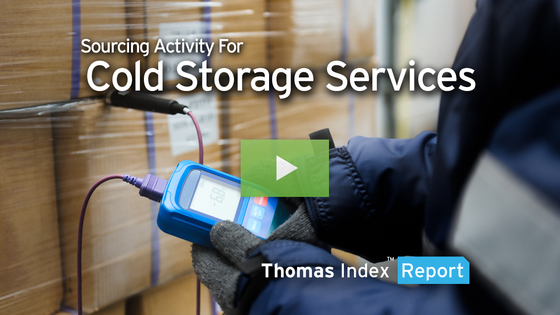Welcome to Thomas Insights — every day, we publish the latest news and analysis to keep our readers up to date on what’s happening in industry. Sign up here to get the day’s top stories delivered straight to your inbox.
This week’s Thomas Index Report is sponsored by Uber Freight. Uber Freight helps streamline your freight operations with instant quotes, real-time tracking, and 24/7 access to trusted carriers.
Welcome to the Thomas Index Report for the week of August 24.
As a quick reminder before we start today’s Index Report, you can find all of our COVID-19 resources and register your industrial business as a COVID-19 Response Supplier by visiting Thomasnet.com/COVID-19.
This week, we’re looking at industrial sourcing activity for cold storage services.
Searches for cold storage services on Thomasnet.com have risen 321% year-over-year and are up by 175% over Q2 averages.
In 2019, the global food cold storage and cold chain market was valued at just over $149 billion. By 2024, that figure is expected to reach $275 billion. But cold storage and the cold supply chain aren’t just essential to the food storage and transport markets – they’re also a critical link for biopharmaceuticals.
Biopharmaceutical cold chain logistics typically utilize trucks for transport but also can ship by air, sea, or rail. A recent report from Pharmaceutical Commerce magazine says that biopharma cold chain logistics spending reached $13.3 billion in 2016. The market was projected to hit $15 billion in 2018 and almost $17 billion in 2020. However, in light of COVID-19 and the global, long-term response to the pandemic, it’s likely those 2020 spending projections may change significantly.
As researchers and pharmaceutical companies race to develop and safely test a vaccine in response to COVID-19, other industry players are also quickly preparing plans for how to transport the vaccine once produced. Because vaccines must be kept within a very specific temperature range to maintain effectiveness, it’s critical that each step of their transport maintains that consistent temperature stability. If even one link in that cold chain transport breaks, it could render the whole batch unusable.
We expect to see a sustained spike in this category on Thomasnet.com over the next few months as preparations for a future COVID-19 vaccine continue.
Image Credit: Thomas Index Report


